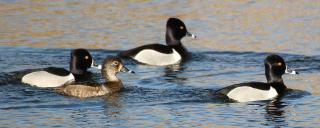 |
| Fact Sheet |
| Scientific Name |
Aythya collaris |
| Wing spread |
28 inches |
| Body length |
17 inches |
| Weight |
1.6 pounds |
| Description |
The ring-necked duck is medium-sized.Males have a purplish iridescent head, black back, white belly and reddish ring around the neck. Females are a nondescript gray brown. Both sexes have a gray bill with white ring and black tip, dark grayish with greenish iridescence on shoulder of wing and a dull pearl gray speculum. |
| Nesting Habitat |
Ring-necked ducks generally nest over water on floating vegetation mats or in clumps of emergent vegetation. |
| Clutch size |
9 eggs |
| Incubation period |
26 days |
| Status in North Dakota |
The ring-necked duck is uncommon during nesting and fall migratory seasons in North Dakota, and often seen in association with scaup. |
| Food habits |
Feeds on aquatic insects, bulrush seeds, sedge and smartweed, as well as the leafy portions of coontail and duckweed. |
| Fun Facts |
Ring-necked ducks tend to feed in shallower water than other diving ducks, usually less than 6 feet deep. Also, they tend to leap into flight like puddle ducks and at times tip up to feed. |


